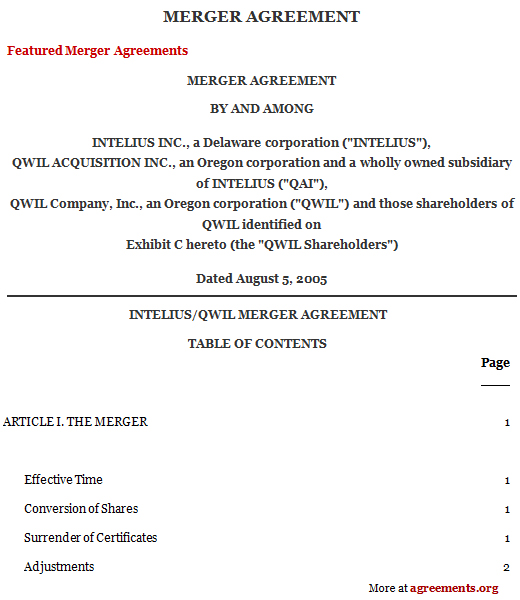When two businesses decide to come together to form a single entity in the interest of enjoying a mutually beneficial position in the market, they are said to engage in a merge. A merger agreement is a document that governs such mergers and is legally binding on the contracting parties. By such an agreement, one business is dissolved (the dissolving entity) into the surviving entity and there is a provision to give the final entity a new name.
This agreement is also called Agreement and Plan of Merger, Merger Agreement Form, and Definitive Merger Agreement.
When Do You Need a Merger Agreement?
You’ll need an agreement of merger in the event that you are a business looking to dissolve into another business, or if you are a business that is looking to have another one dissolve into yours.
The purpose of the agreement is to:
- Codify the terms and conditions mutually agreed upon by the merging entities
- Including those that concern the assets and liabilities of the contracting businesses, their valuation and other important terms, conditions and definitions that will be of legal value in the case of a legal dispute that may arise thereof.
This will be the primary document that will be referred to, in the event of a legal dispute. It is essential that you have the agreement framed in consultation with the other party and their representatives, so as to avoid miscommunication.
Inclusions in Merger Agreement
The most important aspects of a merger agreement include the names of the dissolving entity, surviving entity and the final entity, the date on which the agreement comes into effect, the jurisdiction that governs the merger, the valuation of assets, the distribution of equity in the final entity arising out of the merger and clauses that define the scope of each party’s liability and any limitations thereto.
Other clauses may identify representatives of each party and their legal relationships with the parties, the method of conversion of stock, warranties, and references to other annexes of the document. These agreements are often very complex and it is of utmost importance to ensure that there are no spelling or syntax errors when drafting the document because such errors could have legal implications to the extent where the entire document could be voided because of a single error in syntax.
How to Draft Merger Agreement?
Procedure to draft a merger agreement:
- Decide the date on which the document will come into effect, or the effective date of the agreement.
- Expressly state the names of the dissolving and surviving entities including their addresses.
- Name the final entity arising out of the agreement.
- State the type of the businesses and where they are registered.
- State the activities that both parties have agreed to restrict until finalization of the merger. Also, specify the maximum duration of any contract that either party may enter into until the finalization.
- Ascertain the valuation of the assets and liabilities of each party.
- Specify the conversion ratios for the entities.
- Specify the composition of the board of directors of the final entity and the number of directors that the dissolving entity can nominate.
- Specify the jurisdiction that will govern the new entity.
- Have representatives from both parties sign the agreement.
Benefits of Merger Agreements
- The pooled resources of both businesses will boost the performance and prospects of the entity arising out of the agreement.
- A merger of two competing businesses enhances the business network and market reach of the new surviving entity.
- Mergers improves cost efficiency as the new final entity has greater purchasing power.
- Reduces competition and makes the final entity a new powerhouse that can altogether outperform the rest of the competition.
- Shared research and intellectual property can increase productivity, and help the new entity provide better goods and services to its customers.
- The new final entity would have a larger customer base than either of its component entities would have had as standalone firms.
Key Terms/Clauses in Merger Agreements
- Disclaimer and waiver: These are clauses that are used to limit the liability of the contracting parties.
- Certificate of Merger: This clause states that the representatives of the final entity will produce a Certificate of Merger as may be required under relevant laws.
- Surviving Business Entity: This clause establishes that the legal status of the dissolving entity as a separate, individual legal person would cease to exist post the finalization of the merger and that it would be dissolved into the surviving entity to create the final entity.
- Valuation of assets: This clause clearly defines the value of the assets and liabilities of the contracting parties.
- Conversion Rate: This clause seeks to establish the number of interests in the surviving entity that would equate to each interest in the dissolving entity, and likewise for the surviving and final entities.
[Also Read:Joint Venture Agreement]
Sample Merger Agreement
A sample of the agreement can be downloaded from below.
